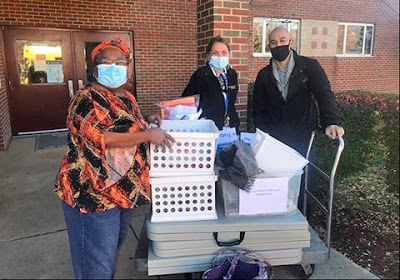Fairfax County School Board delays in-person instruction
 |
| Staff at Poe Middle School prepare new books for delivery to students’ homes. [FCPS] |
The Fairfax County School Board agreed to pause Superintendent Scott Brabrand’s updated plan for returning all students to in-person learning.
Under Brabrand’s proposal, presented at a school board work session Jan. 5, students in groups 1-4 (certain special education and career and technical education students) would return for in-person learning Jan. 12, and all the other groups would be gradually phased in over the next weeks until all students return on Feb. 9.
School board members agreed that schools shouldn’t reopen until there is more information on the availability of COVID-19 vaccines for teachers and community spread of COVID-19. The school board will reconsider the school reopening plan at its Feb. 2 meeting.
The board later passed a resolution requesting the Virginia governor prioritize educators for getting the COVID vaccine.
Brabrand’s proposal also called for school-level decision making for reopening schools that takes community spread of COVID into account. Under that approach, also on hold until the next board meeting, a school in a community with a COVID outbreak could have a delayed reopening for close temporarily while other schools remain open.
Several school board members, including president Ricardy Anderson (Mason) raised objections to that concept, charging it would exacerbate inequities in the system.
“I am extremely concerned about the impact of that,” Anderson said. “That could mean students in different zip codes could have varying access to in-person to educational opportunities.”
“We as a school system have worked for decades on fulfilling the FCPS promise that no matter where you live in Fairfax County you will have a consistent education,” said Karen Corbett Sanders (Mount Vernon). “This is a shift from the One Fairfax approach to a localized approach.”
“I share your concern,” Brabrand said. “We will do everything we can to ensure in-person learning is a reality in every school.”
According to Brabrand, each school will be assigned to one of three options: In-person learning five days a week; hybrid instruction with a mix of in-person and virtual learning; or remote learning for all.
The decisions about individual schools will be made by the leadership team and regional superintendent in consultant with principals.
Even if there is a substantial level of community transmission, a school could be assigned the hybrid option if the level of school impact is low, Brabrand said.
The public is invited to tune in to a town hall on the latest return-to-school plan Jan. 6 at 6 p.m. Questions can be submitted in advance to [email protected].
According to Brabrand’s revised plan, decision making on when it’s safe to return to school would be based on the number of cases in the community per 100,000 people, the percent of positive cases, evidence that mitigation strategies have been implemented, and the availability of sufficient staff.
The lowest risk for in-person learning is when there are less than 50 COVID infections per 100,000 population over the previous 14 days and when the average positivity rate is below 8 percent for 14 days.
Current levels are much higher – 501 cases per 100,000 and a 17 percent positivity rate.
“Recent studies show schools can be open even at high levels of community spread when proper infection-control protocols are consistently implemented,” Brabrand said.
Data from the fall shows low COVID transmission rates in schools, even when there are high rates of infection in the community, he said. The overwhelming majority of COVID infections in schools originated in the community, not from other infected people in school buildings.
So far, 600 students, staff, and visitors in schools tested positive for COVID. Only 54 of those cases involved a possible transmission from another person who had COVID.
There were 20 outbreaks, where there were two or more confirmed COVID cases in a school within a 14-day period that were epidemiologically linked. Seventeen schools had an outbreak, and one school had two outbreaks, Brabrand said.
FCPS dispatched safety teams to schools to monitor the implementation mitigation strategies. Those strategies include the consistent and correct use of masks, social distancing of six feet to the largest extent possible, hand hygiene and respiratory etiquette, cleaning and disinfection, and collaboration with the Fairfax County Health Department on contact tracing.
The lack of staffing has been challenging for reopening schools, Brabrand acknowledged.
FCPS is recruiting classroom monitors to make up for teachers and other staff who have had ADA (Americans with Disability Act) requests approved and have been excused from in-person instruction.
So far, FCPS has hired 447 monitors but still needs another 396.
To close that gap, FCPS will compensate teachers who serve as monitors during the planning period, redeploy central office staff to provide temporary coverage, and reach out to parent groups and other organizations.


Hire retired teachers at the current substitute teacher rate for retired FCPS retired teachers which is about $7 more than what is being offered for a monitor. The school system has saved a considerable amount of money because the number of subs being used is way down. Last year I subbed approximately 45 days by the end of December. This year, just shy of 10 days.
I just retired from a NoVa school district this past summer and I wouldn't go into a public school to sub for any amount of money right now and I need money! Maybe next year.
This useless Superintendent keeps talking back and forth about this same issue since last couple months, we shut the state down and that is it, we understand this state run by Democrats from top to the bottom and this is the way they run the business. He just need to shut up and think of a better solution when out kids get back in-person such as how to get the kids catching up what left for the last twelve months.
fund students not schools.